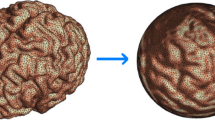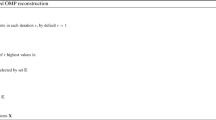Abstract
We consider the problem of detecting the locations of targets in the far field by sending probing signals from an antenna array and recording the reflected echoes. Drawing on key concepts from the area of compressive sensing, we use an ℓ 1-based regularization approach to solve this, generally ill-posed, inverse scattering problem. As is common in compressive sensing, we exploit randomness, which in this context comes from choosing the antenna locations at random. With n antennas we obtain n 2 measurements of a vector \(x \in\mathbb{C}^{N}\) representing the target locations and reflectivities on a discretized grid. It is common to assume that the scene x is sparse due to a limited number of targets. Under a natural condition on the mesh size of the grid, we show that an s-sparse scene can be recovered via ℓ 1-minimization with high probability if n 2≥Cslog2(N). The reconstruction is stable under noise and when passing from sparse to approximately sparse vectors. Our theoretical findings are confirmed by numerical simulations.




Similar content being viewed by others
References
L. Borcea, G. Papanicolaou, C. Tsogka, Theory and applications of time reversal and interferometric imaging, Inverse Probl. 19, 5139–5164 (2003).
M. Born, E. Wolf, Principles of Optics, 7th edn. (Cambridge University Press, Cambridge, 1999).
S. Boyd, L. Vandenberghe, Convex Optimization (Cambridge University Press, Cambridge, 2004).
E.J. Candès, T. Tao, J.K. Romberg, Robust uncertainty principles: exact signal reconstruction from highly incomplete frequency information, IEEE Trans. Inf. Theory 52(2), 489–509 (2006).
E.J. Candès, Y. Plan, A probabilistic and RIPless theory of compressed sensing, IEEE Trans. Inf. Theory 57(11), 7235–7254 (2011).
E.J. Candès, J.K. Romberg, T. Tao, Stable signal recovery from incomplete and inaccurate measurements, Commun. Pure Appl. Math. 59(8), 1207–1223 (2006).
E.J. Candès, T. Tao, Near optimal signal recovery from random projections: universal encoding strategies? IEEE Trans. Inf. Theory 52(12), 5406–5425 (2006).
E.J. Candès, T. Tao, The power of convex relaxation: near-optimal matrix completion, IEEE Trans. Inf. Theory 56(5), 2053–2080 (2010).
A. Chambolle, T. Pock, A first-order primal-dual algorithm for convex problems with applications to imaging, J. Math. Imaging Vis. 40, 120–145 (2011).
S.S. Chen, D.L. Donoho, M.A. Saunders, Atomic decomposition by basis pursuit, SIAM J. Sci. Comput. 20(1), 33–61 (1998).
S. Chrétien, S. Darses, Invertibility of random submatrices via tail decoupling and a matrix Chernoff inequality, Stat. Probab. Lett. 82, 1479–1487 (2012).
V. de la Peña, E. Giné, Decoupling: From Dependence to Independence (Springer, Berlin, 1999).
D.L. Donoho, Compressed sensing, IEEE Trans. Inf. Theory 52(4), 1289–1306 (2006).
A. Fannjiang, P. Yan, T. Strohmer, Compressed remote sensing of sparse objects, SIAM J. Imaging Sci. 3, 595–618 (2010).
M. Fornasier, H. Rauhut, Compressive sensing, in Handbook of Mathematical Methods in Imaging, ed. by O. Scherzer (Springer, Berlin, 2011), pp. 187–228.
S. Foucart, A. Pajor, H. Rauhut, T. Ullrich, The Gelfand widths of ℓ p -balls for 0<p≤1, J. Complex. 26(6), 629–640 (2010).
J.J. Fuchs, On sparse representations in arbitrary redundant bases, IEEE Trans. Inf. Theory 50(6), 1341–1344 (2004).
F. Gruber, E. Marengo, A. Devaney, Time-reversal-based imaging and inverse scattering of multiply scattering point targets, J. Acoust. Soc. Am. 118, 3129–3138 (2005).
Y. Jin, J. Moura, N. O’Donoughue, Time reversal transmission in MIMO radar, in 41. Asilomar Conference on Signals, Systems and Computers, Asilomar (2007), pp. 2204–2208.
S. Kunis, H. Rauhut, Random sampling of sparse trigonometric polynomials II—orthogonal matching pursuit versus basis pursuit, Found. Comput. Math. 8(6), 737–763 (2008).
B.K. Natarajan, Sparse approximate solutions to linear systems, SIAM J. Comput. 24, 227–234 (1995).
J. Nelson, V. Temlyakov, On the size of incoherent systems, J. Approx. Theory 163(9), 1238–1245 (2011).
H.V. Poor, An Introduction to Signal Detection and Estimation (Springer, Berlin, 1994).
D. Potts, G. Steidl, M. Tasche, Fast Fourier transforms for nonequispaced data: A tutorial, in Modern Sampling Theory: Mathematics and Applications, ed. by J. Benedetto, P. Ferreira (Birkhäuser, Boston, 2001), pp. 247–270. Chap. 12.
H. Rauhut, Random sampling of sparse trigonometric polynomials, Appl. Comput. Harmon. Anal. 22(1), 16–42 (2007).
H. Rauhut, Compressive sensing and structured random matrices, in Theoretical Foundations and Numerical Methods for Sparse Recovery, ed. by M. Fornasier. Radon Series Comp. Appl. Math., vol. 9 (De Gruyter, Berlin, 2010), pp. 1–92.
H. Rauhut, G.E. Pfander, Sparsity in time-frequency representations, J. Fourier Anal. Appl. 16(2), 233–260 (2010).
M. Richards, Fundamentals of Radar Signal Processing (McGraw-Hill, New York, 2005).
M. Rudelson, R. Vershynin, On sparse reconstruction from Fourier and Gaussian measurements, Commun. Pure Appl. Math. 61, 1025–1045 (2008).
A. Tolstoy, Matched Field Processing in Underwater Acoustics (World Scientific, Singapore, 1993).
J.A. Tropp, User-friendly tail bounds for sums of random matrices, Found. Comput. Math. 12(4), 389–434 (2012).
J.A. Tropp, Recovery of short, complex linear combinations via l 1 minimization, IEEE Trans. Inf. Theory 51(4), 1568–1570 (2005).
Acknowledgements
M.H. and H.R. acknowledge support by the Hausdorff Center for Mathematics and by the ERC Starting Grant SPALORA StG 258926. T.S. was supported by the National Science Foundation and DTRA under grant DTRA-DMS 1042939, and by DARPA under grant N66001-11-1-4090. Parts of this manuscript have been written during a stay of H.R. at the Institute for Mathematics and Its Applications, University of Minnesota, Minneapolis. T.S. thanks Haichao Wang for useful comments on an early version of this manuscript. The authors also wish to thank Axel Obermeier and the anonymous reviewers for helpful comments and corrections.
Author information
Authors and Affiliations
Corresponding author
Rights and permissions
About this article
Cite this article
Hügel, M., Rauhut, H. & Strohmer, T. Remote Sensing via ℓ 1-Minimization. Found Comput Math 14, 115–150 (2014). https://doi.org/10.1007/s10208-013-9157-9
Received:
Revised:
Accepted:
Published:
Issue Date:
DOI: https://doi.org/10.1007/s10208-013-9157-9




